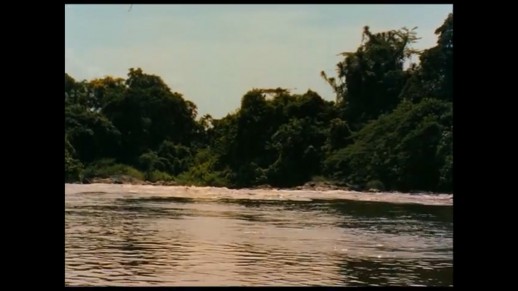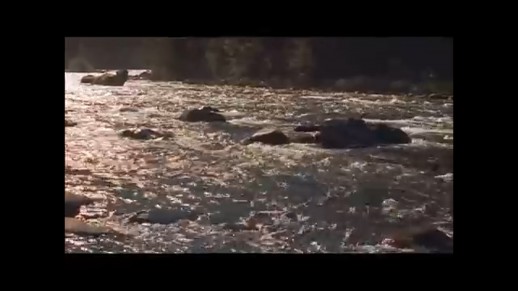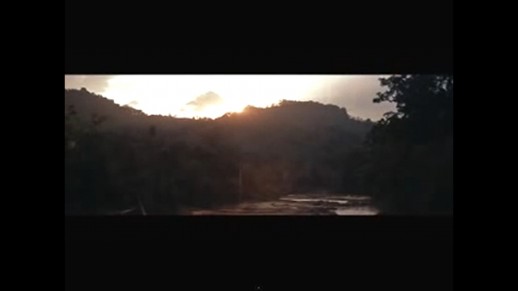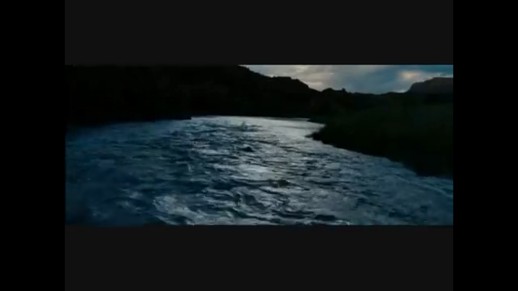By Andrew Ray
Returning recently from the White Cube’s Christian Marclay exhibition I found myself wondering what a riverine version of his twenty-four hour montage film The Clock would be like. Instead of finding clips for every time of the day or night, I imagined looking for rivers in cinema and editing them into a flowing sequence, from source to sea. YouTube may not be a very representative film archive but I had a look anyway. Rivers seem to be fraught with conflict – people are usually being shot at, menaced by crocodiles or being chased towards waterfalls, although I did come across some more tranquil moments too, with a fair amount of fishing and nude bathing. The four rivers here are YouTube screen grabs – whether or not they are recognisable I am not sure*. With actors edited out, they suggest the possibility of a poetic landscape film in the style of William Raban or Chris Welsby made from slices of Hollywood footage. However, it would surely be hard to isolate more than a second or two without the intrusion of dialogue or a cut to action on the boat or the riverbank. Indeed it would be more in keeping with The Clock to see a succession of actors appear and disappear, arguing, laughing, staring ahead or looking anxiously behind as they are carried forward and then disappear from view.
The Clock is circular but a river must have a beginning. Springs would be revealed in film clips as a natural source of drama: discovered, uncovered, concealed. The stream would then grow gradually, small enough initially to be jumped over and fallen into harmlessly. But it is also in these seemingly innocent youthful stages that we would encounter Ronald Reagan spying on Barbara Stanwyck as she bathes in a mountain stream, or find ourselves looking over Daniel Auteuil’s shoulder as he glimpses Emmanuelle Béart in the water below. Eventually the river would speed up and swimming would become impossible. We will see Buster Keaton swept along, the actor’s holdback wire having snapped, the cameras still rolling. We would notice how often the river is a route to freedom – Butch Cassidy and the Sundance Kid eluding their pursuers by leaping into the water, Hawkeye getting away in his canoe, Thorin and the dwarves in their barrels, Tarzan hiding under the surface, breathing through a hollow reed. As the river broadens we will see many strange sights, a conquistador alone on a slowly drifting raft, a navy patrol boat pulling a soldier on water skis as it heads into the heart of darkness, a swan-shaped pedalo carrying Iain Sinclair. There will be cities along the way (where a room with a view will be sought and Boudu will be saved from drowning) and eventually wharves, docks and ocean-going ships. Perhaps the lure of the open sea would make it hard to bring the film to an end.
There would of course be other possibilities. The way the water in these images reflects the light in gold and silvery blue suggests ordering clips according to the time of day, as in The Clock. Or it would be possible to make a different film entirely without focusing on rivers at all, a version of The Clock that excludes all bells and timepieces, based purely on the position of the sun. Sometimes – at daybreak and sunset or towards high noon – the actors would be seen looking up at the sun, but more often they would be oblivious to its presence. These suns would be edited so as to progress smoothly up and across the sky, from dawn to dusk. Time though would fluctuate: a sequence of clips shot in low sun could include action in late afternoon or evening, depending on the latitude and time of year. Seeking to preserve continuity by controlling for these factors too would seem futile, although maybe, left with just a few useably consistent clips, you would by chance end up with what appears to be a coherent story.
Rather than allowing time to progress, as in The Clock, it could be slowed down to an eternal noon or an endless sunset. Perhaps it would be possible to string together twenty-four hours of the sun just rising, so that the viewer would have the impression of chasing it round the world without ever overtaking it. A thunderstorm could be extended beyond its natural duration, with thunder crashing over and over again until it becomes almost unendurable. Rain scenes could be carefully put together in sequence from the finest drops to the most torrential downpour. Mist could thicken into deep fog, snow into blizzard conditions, a gentle breeze could turn into a twister powerful enough to pick up a Kansas farmhouse. Our attention would not be on the worsening weather but the succession of characters that would gradually undergo increasing discomfort and then actual suffering. But perhaps instead it would be more moving to watch a succession of characters registering relief and joy at those moments when the weather starts to turn for the better.
Rivers are natural metaphors for the flow of time, but I can imagine other versions of The Clock that follow actors across different types of landscape. Mountain scenes could be assembled into an ideal mountain ascent, its height only limited by the number of clips that could be found. A cave system would find characters following tunnels and heading up side passages until the film returns to the point at which it started. Completely pathless journeys across seas, deserts or arctic snow would be insufficiently structured, but roads and tracks would work, their routes plotted from hundreds of different plotlines. Walking through a city can feel like the experience of watching a montage: we are continuously passing people acting out scenes in their own lives. A sequence of moments filmed in the streets of London would redraw the city’s map according to the wanderings of actors famous and forgotten, always looking for something or being pursued for reasons difficult to comprehend. But this would really be another kind of film, documenting a particular location rather than being shaped by the notion of a city or a river into which different places, real and imaginary, could be made to fit. Such a project might splice together segments of newsreels, art projects, music videos and amateur cine footage to make a film of the Thames from its contested sources to the North Sea.
If I ever get round to attempting anything like this I would use old movies to make an imaginary river, letting its form be shaped by the cinematic images I could find. But it would be natural to try to sort the footage in various ways, so that more than one river film could be made. I can imagine them showing in adjacent rooms – this one a river of pain, where the characters are always suffering in some way, this one a river of love, then a river of hope, a river of sadness, a river of confusion. These films would reveal the extent to which directors chose landscape settings to mirror the mood of their characters. Music would play a big part in this too – think of Night of the Hunter where one of the children sings ‘Pretty Fly’ as their boat drifts along in the darkness (a scene that Marclay includes in The Clock). Rivers of fear might look genuinely frightening or deceptively tranquil. With isolated clips we never see the full story and nor do the characters – two men paddling contentedly down a sun-dappled river are unaware they are in a scene from Deliverance.
I guess none of these ideas would particularly interest Christian Marclay, whose art is devoted to sound and records, rather than landscape and nature. There was no river water at the White Cube exhibition, just the drips and splashes of action painting which Marclay had painted as comic-book text, as if abstract expressionism was being redone as pop art. While Robert Macfarlane has been compiling his Landmarks glossaries, Marclay has collected a lexicon of superhero sound effects – ‘Zoooom!’ ‘Boom’ ‘Whooosh’ – which he animates and sends flying around gallery walls. In Pub Crawl he has created a surprisingly joyous soundscape by tapping and rolling discarded beer bottles found on weekend morning walks in East London. This may sound like a banal idea but the beauty really comes in the execution. I realise it is easy to imagine new versions of The Clock without going to the trouble of actually trying to make them…
Would a riverine version of The Clock tell us anything new about our changing relationship with rivers? Films are a repository of memories, preserving moments of time that seem to make it possible to step into the same river twice. But while we can re-watch Paul Robeson singing by the Mississippi in Showboat, real rivers don’t just keep rolling along. How many of those that can be seen in old films would now look recognisably the same? How many have been dammed, developed or denuded of wildlife? Landscape has changed in the last hundred years more profoundly than styles of music and fashion and acting. The Clock, without a narrative for the viewer to follow, focuses attention on film’s accidental record of what has gone and what has remained. We may not notice change around us but when we return to a favourite place we recognise what has altered. Revisiting a river is, in this way, different from revisiting a cinema or an art exhibition. As Thoreau says in Walden, “time is but the stream I go a-fishing in. I drink at it; but while I drink I see the sandy bottom and detect how shallow it is. Its thin current slides away, but eternity remains.”
* The four rivers in these images appear in ‘The African Queen’, ‘A River Runs Through It’, ‘The Bridge on the River Kwai’ and ‘No Country for Old Men’. Do we remember landscape features in films specifically enough to recognise them in photographs like these? Perhaps we recognise the atmosphere more than the shape of the river itself. Guessing a film title from one still with no actors is probably no easier than attempting a music quiz where you are only played a single note. But even a note will tell you something about when a record was made and, similarly, it may be possible to tell when these rivers were filmed just from the aspect ratio and colour quality. Whether film images feature clocks or rivers or anything else, they will always have something to say about the passing of time.
Andrew Ray’s Some Landscapes



